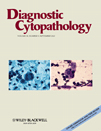Intraoperative cytology—Role in bone lesions
Abstract
In spite of becoming an integral part of surgical pathology, very few reports are available regarding the utility of intraoperative cytology (IOC) exclusively for bone lesions. This study was undertaken in a view to fill this lacuna.
Sixty bone lesions were evaluated intraoperatively with the help of cytology smears prepared by touch, scrape, or crush technique. The diagnosis made on cytological preparation was compared with histopathological diagnosis taking the latter as gold standard. Different parameters like reasons for Intraoperative consultation, best technique for preparation of smear, average time taken to render a diagnosis, and finally the accuracy of IOC was evaluated.
Common reasons for the intraoperative consultation were to make or confirm a diagnosis for proper surgical intervention and to evaluate the surgical resection margin. Scrape was found to be the best method for cytological smear preparation. Average time taken to render a diagnosis was 20 minutes. Sensitivity, specificity, and overall diagnostic accuracy was 96.7, 96.6, and 96.6%, respectively.
Cytology can play a valuable role in the intraoperative diagnosis of bone lesions. The method is simple, cheap, quick, and has no complication. It should be undertaken routinely, as a rapid intraoperative diagnosis will expedite timely and proper management of the patients, along with early post operative treatment and thus avoid the aggravating delays. Diagn. Cytopathol. 2010;38:639–644. © 2009 Wiley-Liss, Inc.




